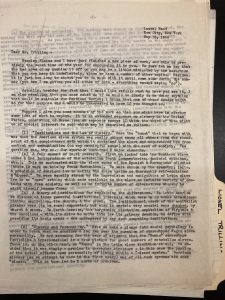After more than a decade working in the RBML, historian Scott Spillman has made unexpected discoveries in the Richard Hofstadter papers, examined a class syllabus that pre-dates historians Stanley Elkins and Eric McKitrick’s landmark collaboration Slavery (1959), and found unexpected correspondence in which Elkins and McKitrick lay out the genesis of their analysis of American slavery to critic Lionel Trilling. Below, Spillman talks more about the many RBML collections he has consulted for his forthcoming book, Making Sense of Slavery: An American History.

What brings you to Columbia’s Rare Book & Manuscript Library?
I wanted to look at the papers of Richard Hofstadter and Eric McKitrick, two historians who were associated with Columbia for most of their careers and who were involved in the study of slavery in the postwar period. Hofstadter was perhaps the most prominent American historian of the era. He wrote only one article on slavery, and it came early in his career, but he was good friends with Kenneth Stampp, who wrote an important book on slavery in 1956, and later advised several students who wrote landmark books on slavery. McKitrick was one of those students. As a graduate student under Hofstadter in the 1950s, he collaborated with Stanley Elkins on Slavery (1959), which appeared under Elkins’s name and became one of the most influential books about slavery in modern American history.
How long have you been using RBML materials (for this and/or previous research)?
I first used RBML materials in 2009, during my first year in graduate school, when I looked at the Christine Ladd-Franklin and Fabian Franklin Papers for a project on Ladd-Franklin’s use of fellowships to advance women’s academic careers around the turn of the twentieth century. The collection was quite rich, giving me enough material for an article in History of Education Quarterly. Two years later, I returned to RBML as I started work on my dissertation on the history of the study of slavery in the United States. I read through the papers of the historian Frederic Bancroft, who wrote an early book about the slave trade and corresponded with many historians of slavery, and also glanced at the papers of a host of other important figures in the development of the academic social sciences and the study of slavery. More recently, as I try to bring my book’s story up to the present, I’ve been using RBML collections again to learn about historians who worked at Columbia in the postwar period. Because Columbia has been a leader in the social sciences in America for more than 150 years now, RBML is probably the best archive in the country for the kind of work that I do.
What have you found? Did you come here knowing this material was here?
In the Hofstadter papers, I found that he sent copies of his 1944 article about slavery, written when he was still a young professor at Maryland, to the most prominent historians across the country. And many of them responded—often with a quick acknowledgment, but sometimes at revealing length. I had no clue these letters would be in his collection, and only stumbled upon them when I looked at some interesting names in his catalogued correspondence.
In the McKitrick papers, I came looking for his correspondence with Stanley Elkins to try to find out more about their collaborative work. In addition to several folders of Elkins letters, I also found the course syllabi in which McKitrick and Elkins first worked out their ideas about slavery, and I found letters to several major intellectuals of the time, including David Riesman and Lionel Trilling, in which McKitrick explained the origins and development of their slavery project. I had no idea any of that material existed—I stumbled upon the Trilling letters only because I had called that box for other reasons and then was intrigued to see a folder with his name on it and opened it up.
What have you found that’s surprised or perplexed you?
I’ve been surprised by nearly everything I’ve learned about McKitrick and his collaborative work with Stanley Elkins. I find their relationship fascinating. Particularly in the 1950s, when those two were first starting out, their work was absolutely thrilling to nearly everyone who saw it. Their energy and intelligence and wit practically jump off the page in McKitrick’s letters, which make for great reading. It also has been incredible to learn of all the intellectual luminaries of the 1950s—David Riesman, Lionel Trilling, Richard Hofstadter, and C. Vann Woodward—who ended up being involved in some way with the Elkins/McKitrick slavery book.
What advice do you have for other researchers or students interested in using RBML’s special collections?
There is no substitute for looking at material in person and opening up any folders and boxes that strike you as puzzling or intriguing. Then turn every page! The work takes time and effort, but it is worth it.